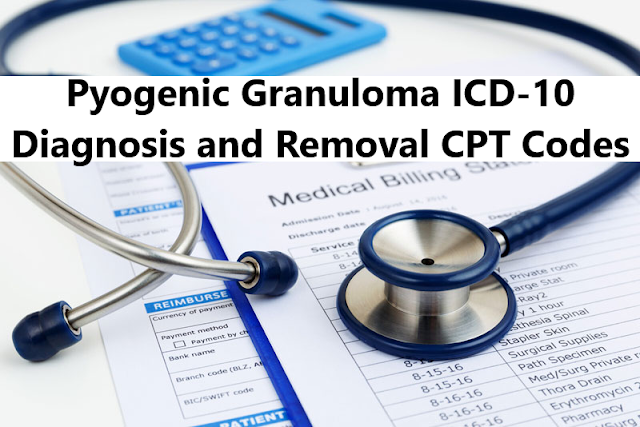Pyogenic granuloma, also known as lobular capillary hemangioma or granuloma telangiectaticum, is classified as a skin and subcutaneous tissue disease by the World Health Organization. These are small, round skin growths that are mainly red in colour. They may bleed due to the large number of blood vessels, but otherwise they are benign lesions. They are common in children and pregnant women and appear on the hands, arms, face, or mouth.
Pyogenic granuloma is usually diagnosed based on its appearance, though a biopsy may be performed by the doctor for a more accurate diagnosis. This also aids in the exclusion of other cancerous conditions such as squamous cell carcinoma, basal cell carcinoma, and melanoma.
Billing services could be helpful for doctors treating pyogenic granuloma in terms of medical coding and documentation.
ICD-10 Diagnosis Code for Pyogenic Granuloma
Pyogenic granuloma is denoted by the ICD-10 code L98.0. It is a billable/specific ICD-10-CM code that can be used to indicate a diagnosis on a medical claim for reimbursement purposes.
Type2 excludes for this code include:
- (K06.8) pyogenic granuloma of gingiva
- (K04.5) pyogenic granuloma of maxillary alveolar ridge
- (K13.4) pyogenic granuloma of oral mucosa
Treatment Procedures for the Condition
In general, physicians treat or eliminate factors that are expected to trigger the condition, reducing the risk of relapse. Methods used include discontinuing any drugs that could aggravate the condition, advising proper oral hygiene, treating any oral trauma caused by teeth, and so on. Cryotherapy, intralesional steroid injection, and topical creams are some of the topical treatments available. Surgical excision, laser treatment, curettage, and cautery are all procedures. Excision treatment is credited with having the lowest recurrence rate.
If any of the following criteria are met, health insurers may consider the removal of benign lesions such as Pyogenic granuloma to be medically necessary.
- A biopsy can detect pre-malignancy or malignancy.
- The anatomic location of the lesion makes it vulnerable to repeated irritation or trauma (for e.g. waist band, bar line, etc.)
- The lesion appears to be pre-malignant or malignant.
- Lesions cause symptoms such as bleeding, intense itching, burning, or irritation.
- The lesion exhibits signs of inflammation, such as erythema, edoema, or purulence.
- The lesion is contagious.
- The lesion impairs vision or obstructs a body orifice.
In the absence of the above- mentioned indications, the removal of a benign skin lesion is considered cosmetic and non-reimbursable.
Procedure Codes for Removal of Pyogenic Granuloma
Pyogenic granuloma is a benign skin lesion that can be removed. However, proper medical record documentation is required to establish why excisional removal was chosen for reasons other than cosmetic purposes. The code is chosen by measuring the apparent lesion's maximum clinical diameter plus the margin required for complete excision (the excised diameter is the lesion diameter plus the narrowest margins required). Based on the treating physician's judgement, the margins indicate the narrowest margin required to properly excise the lesion. Each medical claim must be submitted with the appropriate ICD-10 code indicating the patient's condition, as well as the reason for which the service was performed.
The following CPT codes can be used in combination with a L98.0 diagnosis code for Pyogenic granuloma.
- 11300 ‐ 11313 Shaving epidermal or dermal lesions
- 11400 ‐ 11446 Excision, benign lesions
- 17110 Removal of benign lesions other than skin tags or cutaneous vascular proliferative lesions (e.g., laser surgery, electrosurgery, cryosurgery, chemosurgery, surgical curettement). This code is to be reported with one unit of service for the removal of up to 14 benign lesions other than skin tags or cutaneous vascular lesions.
- 17111 Removal (e.g., laser surgery, electrosurgery, cryosurgery, chemosurgery, surgical curettement) of benign lesions other than skin tags or cutaneous vascular proliferative lesions. This code must be reported with one unit of service representing 15 or more lesions.
Anesthesia and simple closure are usually included in the excision code. If the procedure included extensive undermining, 2-layer closure, and skin removal, a separate code for moderately complex closure must be used.
Each lesion's size and location, as well as the type of removal, must be clearly documented. When samples of one or more of a group of lesions are taken for diagnosis, a biopsy code may also be used.
The correct codes on medical claims are critical for receiving payment for your services. Make sure that your medical coding and documentation are flawless, dependable, and support medical necessity. Medical billing companies can offer the assistance that physicians require to ensure accurate medical coding and claim submission to payers.


Post a Comment
Webmaster reserves the rights to edit/remove comments that is found irrelevant, offensive, contain profanity, serves as spam or attempts to harbor irrelevant links. Please read our Comments Policy for details.